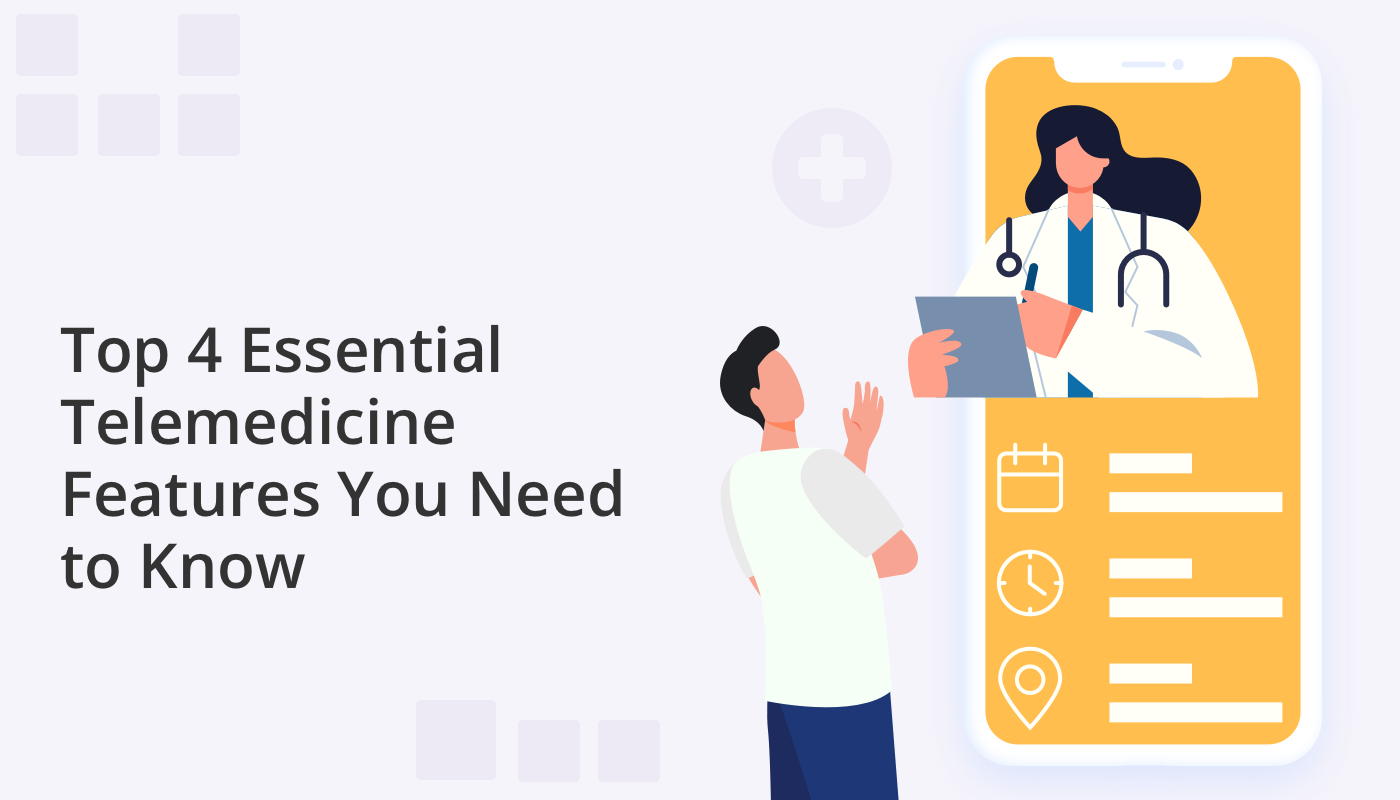
Summary: This blog explores the benefit and application of four essential telemedicine features that elevate the quality of online patient engagement – video consultation, secure messaging, real time data sharing, and remote monitoring. In addition, this blog will provide real use case examples of how these critical features have been used for telemedicine success.
Introduction
In an era where accessibility, efficiency, and personalized care are at the forefront of healthcare priorities, understanding and harnessing the power of essential telemedicine features is not just a choice but a necessity. From interactive video consultations that bring the doctor’s office to the patient’s home, to secure messaging platforms fostering real-time communication, this guide will navigate the diverse array of tools and technologies designed to enhance patient-provider interactions.
Learn more about, Top HIPAA Compliant Chat Apps
Crucial Telehealth Software Features
According to a study published by the CDC, telemedicine usage continues to flourish in the post-pandemic era with 37% of American adults aged 18 and over using remote healthcare services. A McKinsey report found that use of telehealth services had increased 38 times higher than compared with the pre-COVID-19 baseline, while research published in Primary Care also confirmed that telemedicine “will remain an integral part of medical care.”
As the demand for remote healthcare surges, the efficacy of telehealth platforms hinges on their software backbone. There are several telehealth software features that lead to telemedicine success, these include user-friendly interfaces, the ability for customization, easy integration with EHR systems, strong security protocols, as well as high-performance communication functionality.
In the following we will focus on four critical telemedicine features that contribute to positive patient experience and health outcomes:
Core Features for Virtual Healthcare
1. Interactive Video Consultations
In the realm of telemedicine, one of the most transformative features revolutionizing patient interaction is the advent of interactive video consultations. These virtual face-to-face encounters bridge the physical gap between healthcare providers and their patients, offering a dynamic and immersive experience that extends beyond traditional communication methods.
The significance of face-to-face virtual interactions cannot be overstated. In the absence of a physical presence, video consultations provide a rich medium for doctors to observe non-verbal cues, assess symptoms, and establish a more profound connection with their patients. This visual component adds a human touch to the virtual encounter, fostering a sense of trust and familiarity crucial in the patient-provider relationship.
Interactive video platforms are equipped with features designed to optimize the virtual consultation experience. High-definition video quality ensures clarity in communication, allowing healthcare professionals to conduct thorough examinations and consultations remotely. Real-time chat and file-sharing features further enhance the interactive nature of these platforms, facilitating seamless communication between doctors and patients.
Moreover, the flexibility afforded by interactive video consultations is a key benefit. Patients can access medical expertise from the comfort of their homes, eliminating the need for travel and reducing associated stress. This not only enhances convenience for patients but also opens up new avenues for healthcare providers to reach a broader audience.
These successful implementations underscore the adaptability and effectiveness of interactive video consultations in diverse healthcare settings. As technology continues to advance, the potential for these platforms to enhance patient interaction and healthcare delivery is limitless.
Secure messaging platforms have also emerged as indispensable tools in telemedicine, facilitating real-time communication between healthcare providers and patients. The emphasis on security is paramount, ensuring that sensitive medical information is exchanged efficiently while maintaining the utmost confidentiality.
Secure messaging platforms play a pivotal role in fostering timely communication, allowing patients and healthcare providers to connect instantly without compromising data security. In the realm of telemedicine, where quick responses and accessibility are crucial, these platforms become instrumental in addressing queries, sharing updates, and ensuring a continuous flow of information.
By incorporating secure messaging into telemedicine practices, healthcare providers can extend their reach and offer responsive care, enabling patients to communicate with their healthcare team at their convenience. This real-time interaction contributes to enhanced patient engagement and satisfaction, laying the foundation for better healthcare outcomes.
Optimizing the use of secure messaging platforms involves implementing practical strategies to ensure effective communication. Healthcare providers can establish clear guidelines for patients on when and how to use secure messaging, encouraging its use for non-emergency inquiries, appointment scheduling, and medication-related discussions.
Moreover, incorporating notification systems and response time expectations helps manage patient expectations and ensures that healthcare providers can respond promptly to incoming messages. By integrating secure messaging into the broader telemedicine framework, healthcare professionals can streamline communication workflows and provide a more comprehensive and patient-centric virtual experience.
3. Real time data sharing
As telemedicine continues to evolve, the ability to share real-time data emerges as a pivotal feature, significantly impacting the quality of care and informed decision-making. The seamless exchange of medical information between healthcare providers and patients fosters a collaborative approach, ensuring that decisions are grounded in the most up-to-date and accurate data available.
Real-time data exchange is a cornerstone of effective telemedicine, empowering healthcare professionals to make informed decisions based on the latest patient information. This feature facilitates the sharing of medical records, test results, and vital signs in real-time, creating a dynamic and comprehensive understanding of a patient’s health status.
In scenarios where timely intervention is critical, such as acute medical conditions or rapidly changing symptoms, real-time data sharing becomes a lifeline, enabling healthcare providers to respond promptly and tailor treatment plans to evolving circumstances. This immediacy in information transfer is particularly valuable in emergency telemedicine situations and ongoing remote monitoring scenarios.
A variety of platforms and technologies facilitate real-time data sharing in telemedicine. Electronic Health Record (EHR) systems serve as centralized repositories for patient information, ensuring that healthcare providers have access to a patient’s medical history, prescriptions, and diagnostic results in real-time. Integrating telemedicine platforms with EHR systems enhances the continuity of care by providing a holistic view of a patient’s health profile.
Furthermore, cloud-based solutions and secure servers enable the secure and instant transfer of large datasets, such as medical imaging files or continuous monitoring data. These technologies contribute to the accessibility and efficiency of real-time data sharing, laying the groundwork for collaborative and data-driven decision-making.
The impact of real-time data sharing extends to diagnostic accuracy and treatment planning. By arming healthcare providers with the most recent and comprehensive patient data, telemedicine ensures that diagnoses are well-informed and treatment strategies are tailored to individual patient needs. This not only improves the overall quality of care but also contributes to more efficient and cost-effective healthcare delivery.
4. Remote monitoring
Remote monitoring stands as a testament to the transformative power of virtual healthcare. Remote monitoring goes beyond episodic interactions, providing a continuous stream of real-time health data and facilitating home healthcare. This feature is particularly impactful for chronic disease management, preventive care, and the extension of healthcare services beyond traditional physical boundaries.
Remote patient monitoring (RPM) features in telemedicine offer a proactive approach to healthcare by allowing continuous tracking of vital signs, symptoms, and other relevant health metrics. Through the use of connected devices and wearable technology, patients can transmit data to healthcare providers in real-time, enabling a more comprehensive understanding of their health status.
This feature is especially valuable for individuals with chronic conditions, allowing healthcare providers to monitor fluctuations, detect early warning signs, and intervene promptly, all from a distance. Moreover, remote monitoring can be utilized for post-surgical care, rehabilitation, and general wellness tracking, extending the scope of healthcare services to the comfort of patients’ homes.
A diverse array of devices and technologies supports remote health tracking in telemedicine. Wearable devices, such as smartwatches and fitness trackers, can monitor vital signs, physical activity, and sleep patterns. Home-based monitoring devices, such as blood pressure cuffs, glucose meters, and digital scales, provide valuable data for individuals managing chronic conditions.
Integration with telemedicine platforms allows these devices to transmit data seamlessly to healthcare providers, creating a continuous feedback loop. Artificial intelligence algorithms can analyze this data, identifying patterns and anomalies that may require attention. The combination of remote monitoring devices and advanced technologies enhances the precision and efficiency of virtual healthcare delivery.
Critical Features for Telemedicine Success: examples of real use cases
In the realm of telemedicine, success stories abound, showcasing the transformative impact of maximizing patient interaction through utilizing core features of virtual healthcare. In the following section we’ll highlight the tangible benefits achieved by healthcare providers leveraging telemedicine to its fullest potential.
Virtual Urgent Care: Expedited Access and Enhanced Patient Satisfaction
One notable success story revolves around a virtual urgent care service that successfully implemented interactive video consultations and secure messaging platforms. By offering patients expedited access to healthcare professionals, this service significantly reduced wait times for urgent medical concerns. Patients were able to connect with healthcare providers in real-time, receive prompt assessments, and obtain timely guidance on necessary interventions. The integration of secure messaging further allowed for continuous communication, enabling patients to seek clarification and updates seamlessly. The result was not only improved patient satisfaction but also a streamlined and efficient urgent care service that effectively utilized telemedicine features.
Chronic Disease Management: Empowering Patients and Improving Outcomes
In another case study focusing on chronic disease management, a healthcare provider implemented a comprehensive telemedicine strategy that included remote monitoring and integration with EHR systems. Patients with chronic conditions, such as diabetes and hypertension, were equipped with wearable devices for continuous health tracking. The collected data seamlessly integrated with the EHR, allowing healthcare providers to monitor patients’ vital signs in real-time. The personalized insights gained through telemedicine features empowered patients to actively manage their conditions, leading to improved adherence to treatment plans and better overall health outcomes. This case study underscores the potential of telemedicine in transforming chronic disease management into a collaborative and patient-centric process.
Mental Health Support: Breaking Barriers and Promoting Accessibility
A compelling success story in mental health support revolves around a telepsychiatry program that prioritized accessibility and user experience. By offering interactive video consultations and secure messaging platforms for ongoing support, the program successfully reduced barriers to mental health care. Patients, regardless of geographical location, were able to connect with mental health professionals for timely interventions and support. The secure and confidential nature of the communication platforms fostered a sense of trust among patients, leading to increased engagement and adherence to treatment plans. This case study exemplifies the potential of telemedicine to break down barriers and expand access to crucial mental health services.
These case studies collectively demonstrate the diverse applications of essential telemedicine features in enhancing patient interaction and reshaping the healthcare landscape. By learning from these successes, healthcare providers can glean valuable insights into the practical implementation of telemedicine strategies for optimal patient outcomes.
QuickBlox Provides Crucial Telehealth Software Features
As telemedicine continues to evolve, its capacity to bridge geographical gaps, streamline communication, and empower patients holds immense potential to revolutionize healthcare delivery. Healthcare professionals can leverage the full spectrum of telemedicine features to maximize patient interaction and drive superior healthcare outcomes. Incorporating telemedicine into practice not only enhances accessibility and efficiency but also contributes to a patient-centric approach that transcends traditional boundaries. Patients can embrace the opportunities presented by telemedicine to actively participate in their healthcare journey – utilizing interactive video consultations, secure messaging, and remote monitoring to proactively manage their health. Telemedicine empowers individuals, breaking down barriers and offering a pathway to a more accessible, personalized, and responsive healthcare experience.
QuickBlox provides crucial telehealth communication software features that not only meet but exceed industry standards, including video calling, in-app chat, and AI integration. With a commitment to innovation, security, and seamless integration, QuickBlox stands as a catalyst for shaping the future of telehealth. Contact us to learn more.
Talk to a sales expert
Learn more about our products and get your questions answered.
Contact sales






